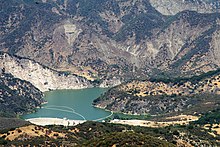Gibraltar Dam
| Gibraltar Dam | |
|---|---|
 | |
| Country | United States |
| Location | Santa Barbara County, California |
| Coordinates | 34°31′37″N 119°41′13″W / 34.52694°N 119.68694°W |
| Opening date | 1920[1] |
| Dam and spillways | |
| Type of dam | Concrete arch |
| Impounds | Santa Ynez River |
| Height | 194.5 ft (59.3 m)[1] |
| Length | 600 ft (180 m)[1] |
| Reservoir | |
| Creates | Gibraltar Reservoir |
| Total capacity | Original: 14,500 acre⋅ft (17,900,000 m3)[2] Current: 7,630 acre⋅ft (9,410,000 m3)[1] |
| Catchment area | 216 sq mi (560 km2)[1] |
| Surface area | 248 acres (100 ha)[1] |
Gibraltar Dam is located on the Santa Ynez River, in Santa Barbara County, California, in the United States. Forming Gibraltar Reservoir, the dam is owned by the city of Santa Barbara and its primary purpose is municipal water supply. The dam and reservoir provide about 4,600 acre-feet (5,700,000 m3) to Santa Barbara each year, supplying 29.4% of the city's water.[3]
Completed in 1920 just above Devils Canyon, about 5 miles (8.0 km) north of Santa Barbara across the Santa Ynez Mountains, the dam was originally a concrete arch structure about 170 feet (52 m) high, impounding a reservoir with a capacity of 14,500 acre-feet (17,900,000 m3). Gibraltar was the first major dam built on the Santa Ynez River.[4] Diversions from the dam greatly supplemented the flow of water through the Mission Tunnel, which was excavated in 1912 to intercept groundwater flow under the Santa Ynez Mountains and channel it south to Santa Barbara. It was not until 1922 when Gibraltar Reservoir first reached capacity.[2]

The reservoir has suffered from heavy sedimentation, and by 1948 was left with just 7,800 acre-feet (9,600,000 m3) – 53.8% of the original capacity. To address this problem the dam was raised to a height of 194.5 feet (59.3 m) and a new buttressed spillway section added, again increasing storage capacity to 14,500 acre-feet (17,900,000 m3). By the early 21st century, the reservoir's capacity had been reduced to 7,264 acre-feet (8,960,000 m3).[3] Attempts have been made to slow the rate of silting, including the construction of the Mono and Agua Caliente debris dams that together have prevented 1,089 acre-feet (1,343,000 m3) of sediment from reaching Gibraltar,[5] but the reservoir continues to accumulate sediment at a rate of 150 acre-feet (190,000 m3) per year.[2]
See also
References
- ^ a b c d e f "Gibraltar Dam". National Dam Performance Program. Stanford University. Archived from the original on 2012-12-11. Retrieved 2012-09-18.
{{cite web}}: Unknown parameter|dead-url=ignored (|url-status=suggested) (help) - ^ a b c "Surface Water" (PDF). Water Supplies. Santa Barbara County. Retrieved 2012-09-18.
- ^ a b "Water Supply: Reservoirs, Groundwater, State Water Project and more". Water & Wastewater. City of Santa Barbara. 2010-12-08. Retrieved 2012-09-18.
- ^ "Cachuma Project". U.S. Bureau of Reclamation. 2011-04-18. Retrieved 2012-09-18.
- ^ Brown, Carl Barrier (1944). The Control of Reservoir Silting: Issue 521 of United States Department of Agriculture, Misc. Publication. United States Government. pp. 35–36.
